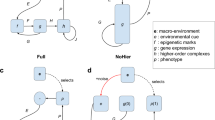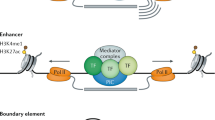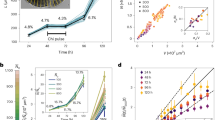Abstract
Comparative developmental evidence indicates that reorganizations in developmental gene regulatory networks (GRNs) underlie evolutionary changes in animal morphology, including body plans. We argue here that the nature of the evolutionary alterations that arise from regulatory changes depends on the hierarchical position of the change within a GRN. This concept cannot be accomodated by microevolutionary nor macroevolutionary theory. It will soon be possible to investigate these ideas experimentally, by assessing the effects of GRN changes on morphological evolution.
This is a preview of subscription content, access via your institution
Access options
Subscribe to this journal
Receive 12 print issues and online access
$189.00 per year
only $15.75 per issue
Buy this article
- Purchase on Springer Link
- Instant access to full article PDF
Prices may be subject to local taxes which are calculated during checkout


Similar content being viewed by others
References
Davidson, E. H. The Regulatory Genome (Academic, San Diego, 2006).
Oliveri, P., Tu, Q. & Davidson, E. H. Global regulatory logic for specification of an embryonic cell lineage. Proc. Natl Acad. Sci. USA 105, 5955–5962 (2008).
Smith, J. & Davidson, E. H. Gene regulatory network subcircuit controlling a dynamic spatial pattern of signaling in the sea urchin embryo. Proc. Natl Acad. Sci. USA 105, 20089–20094 (2008).
Stathopoulos, A. & Levine, M. Genomic regulatory networks and animal development. Dev. Cell 9, 449–462 (2005).
Nikitina, N., Sauka-Spengler, T. & Bronner-Fraser, M. Dissecting early regulatory relationships in the lamprey neural crest gene regulatory network. Proc. Natl Acad. Sci. USA 105, 20083–20088 (2008).
Georgescu, C. et al. A gene regulatory network armature for T-lymphocyte specification. Proc. Natl Acad. Sci. USA 105, 200100–200105 (2008).
Ben-Tabou de-Leon, S. & Davidson, E. H. Experimentally based sea urchin gene regulatory network and the causal explanation of developmental phenomenology. Wiley Interdiscip. Rev. Syst. Biol. Med. (in the press).
Gene networks in animal development and evolution special feature Sackler Colloquium. Proc. Natl Acad. Sci. USA (in the press).
Davidson, E. H. Developmental biology at the systems level. Biochim. Biophys. Acta Gene Reg. Mech. (in the press).
Davidson, E. H. & Erwin, D. H. Gene regulatory networks and the evolution of animal body plans. Science 311, 796–800 (2006).
Wray, G. A. The evolutionary significance of cis-regulatory mutations. Nature Rev. Genet. 8, 206–216 (2007).
Carroll, S. B. Evo–devo and an expanding evolutionary synthesis: a genetic theory of morphological evolution. Cell 134, 25–36 (2008).
Prud'homme, B. et al. Repeated morphological evolution through cis-regulatory changes in a pleiotropic gene. Nature 440, 1060–1053 (2006).
Wray, G. A. et al. The evolution of transcriptional regulation in eukaryotes. Mol. Biol. Evol. 20, 1377–1419 (2003).
Davidson, E. H. A view from the genome: spatial control of transcription in sea urchin development. Curr. Opin. Genet. Dev. 9, 530–541 (1999).
Wittkopp, P. J., True, J. R. & Carroll, S. B. Reciprocal functions of the Drosophila Yellow and Ebony proteins in the development and evolution of pigment patterns. Development 129, 1849–1858 (2002).
Gompel, N., Prud'homme, B., Wittkopp, P. J., Kassner, V. A. & Carroll, S. B. Chance caught on the wing: cis-regulatory evolution and the origin of pigment patterns in Drosophila. Nature 433, 481–487 (2005).
Wittkopp, P. J., Vaccaro, K. & Carroll, S. B. Evolution of yellow gene regulation and pigmentation in Drosophila. Curr. Biol. 12, 1547–1556 (2002).
Jeong, S., Rokas, A. & Carroll, S. B. Regulation of body pigmentation by the Abdominal-B Hox protein and its gain and loss in Drosophila evolution. Cell 125, 1387–1399 (2006).
Shapiro, M. D. et al. Genetic and developmental basis of evolutionary pelvic reduction in threespine sticklebacks. Nature 428, 717–723 (2004).
Jeong, S. et al. The evolution of gene regulation underlies a morphological difference between two Drosophila sister species. Cell 132, 783–793 (2008).
Chanut-Delalande, H., Fernandes, I., Roch, F., Payre, F. & Plaza, S. Shavenbaby couples patterning to epidermal cell shape control. PLoS Biol. 4, e290 (2006).
McGregor, A. P. et al. Morphological evolution through multiple cis-regulatory mutations at a single gene. Nature 448, 587–590 (2007).
Sucena, E., Delon, I., Jones, I., Payre, F. & Stern, D. L. Regulatory evolution of shavenbaby/ovo underlies multiple cases of morphological parallelism. Nature 424, 935–938 (2003).
Hersh, B. M. & Carroll, S. B. Direct regulation of knot gene expression by Ultrabithorax and the evolution of cis-regulatory elements in Drosophila. Development 132, 1567–1577 (2005).
Walsh, C. M. & Carroll, S. B. Collaboration between Smads and a Hox protein in target gene repression. Development 134, 3585–3592 (2007).
Weatherbee, S. D., Halder, G., Kim, J., Hudson, A. & Carroll, S. Ultrabithorax regulates genes at several levels of the wing-patterning hierarchy to shape the development of the Drosophila haltere. Genes Dev. 12, 1474–1482 (1998).
Galant, R. & Carroll, S. B. Evolution of a transcriptional repression domain in an insect Hox protein. Nature 415, 910–913 (2002).
Hersh, B. M. et al. The UBX-regulated network in the haltere imaginal disc of D. melanogaster. Dev. Biol. 302, 717–727 (2007).
Hinman, V. F., Nguyen, A. T., Cameron, R. A. & Davidson, E. H. Developmental gene regulatory network architecture across 500 million years of echinoderm evolution. Proc. Natl Acad. Sci. USA 100, 13356–13361 (2003).
Hinman, V. F., Nguyen, A. & Davidson, E. H. Caught in the evolutionary act: precise cis-regulatory basis of difference in the organization of gene networks of sea stars and sea urchins. Dev. Biol. 312, 584–595 (2007).
Angelini, D. R. & Kaufman, T. C. Insect appendages and comparative ontogenetics. Dev. Biol. 286, 57–77 (2005).
Stopper, G. F. & Wagner, G. P. Of chicken wings and frog legs: a smorgasbord of evolutionary variation in mechanisms of tetrapod limb development. Dev. Biol. 288, 21–39 (2005).
Abzhanov, A. et al. The calmodulin pathway and evolution of elongated beak morphology in Darwin's finches. Nature 442, 563–567 (2006).
Abzhanov, A., Protas, M., Grant, B. R., Grant, P. R. & Tabin, C. J. Bmp4 and morphological variation of beaks in Darwin's finches. Science 305, 1462–1465 (2004).
Lin, C. M., Jiang, T. X., Widelitz, R. B. & Chuong, C. M. Molecular signaling in feather morphogenesis. Curr. Opin. Cell Biol. 18, 730–741 (2006).
Wu, P. et al. Evo–devo of amniote integuments and appendages. Int. J. Dev. Biol. 48, 249–270 (2004).
Revilla-i-Domingo, R., Minokawa, T. & Davidson, E. H. R11: a cis-regulatory node of the sea urchin embryo gene network that controls early expression of SpDelta in micromeres. Dev. Biol. 274, 438–451 (2004).
Ransick, A. & Davidson, E. H. cis-regulatory processing of Notch signaling input to the sea urchin glial cells missing gene during mesoderm specification. Dev. Biol. 297, 587–602 (2006).
Shapiro, M. D., Bell, M. A. & Kingsley, D. M. Parallel genetic origins of pelvic reduction in vertebrates. Proc. Natl Acad. Sci. USA 103, 13753–13758 (2006).
Gomez-Skarmeta, J. L. et al. Cis-regulation of achaete and scute: shared enhancer-like elements drive their coexpression in proneural clusters of the imaginal discs. Genes Dev. 9, 1869–1882 (1995).
Calleja, M. et al. How to pattern an epithelium: lessons from achaete–scute regulation on the notum of Drosophila. Gene 292, 1–12 (2002).
Maeder, M. L., Polansky, B. J., Robson, B. E. & Eastman, D. A. Phylogenetic footprinting analysis in the upstream regulatory regions of the Drosophila Enhancer of split genes. Genetics 177, 1377–1394 (2007).
Singson, A., Leviten, M. W., Bang, A. G., Hua, X. H. & Posakony, J. W. Direct downstream targets of proneural activators in the imaginal disc include genes involved in lateral inhibitory signaling. Genes Dev. 8, 2058–2071 (1994).
Wulbeck, C. & Simpson, P. Expression of achaete–scute homologues in discrete proneural clusters on the developing notum of the medfly Ceratitis capitata, suggests a common origin for the stereotyped bristle patterns of higher Diptera. Development 127, 1411–1420 (2000).
Wulbeck, C. & Simpson, P. The expression of pannier and achaete–scute homologues in a mosquito suggests an ancient role of pannier as a selector gene in the regulation of the dorsal body pattern. Development 129, 3861–3871 (2002).
Pistillo, D., Skaer, N. & Simpson, P. scute expression in Calliphora vicina reveals an ancestral pattern of longitudinal stripes on the thorax of higher Diptera. Development 129, 563–572 (2002).
Keys, D. N. et al. Recruitment of a hedgehog regulatory circuit in butterfly eyespot evolution. Science 283, 532–534 (1999).
Gao, F. & Davidson, E. H. Transfer of a large regulatory apparatus to a new developmental address in echinoid evolution. Proc. Natl Acad. Sci. USA 105, 6091–6096 (2008).
Ronshaugen, M., McGinnis, N. & McGinnis, W. Hox protein mutation and macroevolution of the insect body plan. Nature 415, 914–917 (2002).
Fondon, J. W. III & Garner, H. R. Molecular origins of rapid and continuous morphological evolution. Proc. Natl Acad. Sci. USA 101, 18058–18063 (2004).
Schwenk, K. & Wagner, G. P. Function and the evolution of phenotypic stability: connecting pattern to process. Am. Zool. 41, 552–563 (2001).
Stern, D. L. Evolutionary developmental biology and the problem of variation. Evolution 54, 1079–1091 (2000).
Riedl, R. Order in Living Organisms (John Wiley & Sons, Chichester, 1978).
Wimsatt, W. C. in From Embryology to Evo–Devo (eds Laubichler, M. D. & Mainenschein, J.) 310–355 (MIT Press, Cambridge, Massachusetts, 2007).
Wimsatt, W. C. in Cycles of Contingency (eds Oyama, S., Griffiths, P. E. & Gray, R. D.) 219–237 (MIT Press, Cambridge, Massachusetts, 2001).
Jablonski, D. Scale and hierarchy in macroevolution. Palaeontology 50, 87–109 (2007).
Gould, S. J. The Structure of Evolutionary Theory (Harvard Univ. Press, Cambridge, Massachusetts, 2002).
Stanley, S. M. Macroevolution (W. H. Freeman, San Francisco, 1979).
Jablonski, D. Micro- and macroevolution: scale and hierarchy in evolutionary biology and paleobiology. Paleobiology 26, 15–52 (2000).
Dean, A. M. & Thornton, J. W. Mechanistic approaches to the study of evolution: the functional synthesis. Nature Rev. Genet. 8, 675–688 (2007).
Cretekos, C. J. et al. Regulatory divergence modifies limb length between mammals. Genes Dev. 22, 141–151 (2008).
Valentine, J. W. On the Origin of Phyla (Univ. Chicago Press, Chicago, 2004).
Erwin, D. H. Disparity: morphologic pattern and developmental context. Palaeontology 50, 57–73 (2007).
Gilchrist, M. et al. Systems biology approaches identify ATF3as a negative regulator of Toll-like receptor 4. Nature 441, 173–178 (2006).
Christiaen, L. et al. The transcription/migration interface in heart precursors of Ciona intestinalis. Science 320, 1349–1352 (2008).
Acknowledgements
We appreciate the helpful comments from several reviewers. D.H.E. acknowledges support from the NASA Astrobiology Program, and E.H.D. from the National Science Foundation (IOS 0641398).
Author information
Authors and Affiliations
Corresponding author
Supplementary information
Related links
Related links
FURTHER INFORMATION
Glossary
- Additive genetic variation
-
The portion of genetic variance that is attributable to the average effect of substitution of one allele for another at a locus; it is used to predict the rate of response to selection for quantitative traits.
- Body plan
-
The conserved aspects of morphology that define major clades, recognized in a Linnean hierarchy as phyla, classes and perhaps orders.
- Fixation
-
Describes the situation in which a mutation has achieved a frequency of 100% in a natural population.
- Haltere
-
Club-shaped modified hind wings on Drosophila species that serve as gyroscopic sense organs.
- Heterochronic
-
An evolutionary change in the timing of a developmental process, so that a character or process occurs earlier or later in ontogeny, or grows at a different rate.
- Imaginal disc
-
Epidermal thickenings in the larvae of holometabolous insects. The discs contain mesodermal cells that give rise to adult organs.
- Integumental
-
Relating to the skin; appendages that grow out of the skin.
- Lockdown
-
Establishment of a stable regulatory state by instituting positive feedback between regulatory genes that ensures continued transcription of the participating genes and those operating downstream of them in the GRN.
- Macroevolution
-
Evolution above the species level, including species-level trends, and putatively encompassing selection at the level of species and clades.
- Microevolution
-
Evolution within species and often the formation of new species; this is experimentally accessible through studies of shifting gene frequencies in populations.
- Neofunctionalization
-
Acquisition by a duplicated gene of a new function compared with the original common ancestral function.
- Notum
-
The dorsal portion of an insects thoracic segment.
- Outgroup
-
The most distantly related group in a phylogenetic analysis; it is used to establish the sequence and polarity of evolutionary changes.
- Pleisiomorphic
-
Character states of an organism that were present before the last common ancestor of a clade.
- Purifying internal selection
-
The elimination of genetic variation except around a single mode, by selection against non-viable developmental mutants.
- Regulatory state
-
The set of active transcription factors in every cell at any time point.
- Subfunctionalization
-
Retention by duplicated genes of different components of the original common ancestral function, which allows both gene copies to be preserved.
- Trichome
-
Small hairs, specifically on the epidermis of Drosophila species.
- Uniformitarianism
-
The assumption that studies of present processes are sufficient to understand past events, because there is a single common underlying evolutionary process that accounts for changes at every level.
Rights and permissions
About this article
Cite this article
Erwin, D., Davidson, E. The evolution of hierarchical gene regulatory networks. Nat Rev Genet 10, 141–148 (2009). https://doi.org/10.1038/nrg2499
Issue Date:
DOI: https://doi.org/10.1038/nrg2499
This article is cited by
-
Early expression onset of tissue-specific effector genes during the specification process in sea urchin embryos
EvoDevo (2023)
-
Feedback circuits are numerous in embryonic gene regulatory networks and offer a stabilizing influence on evolution of those networks
EvoDevo (2023)
-
Single-cell dissection of aggression in honeybee colonies
Nature Ecology & Evolution (2023)
-
Evolvability and Macroevolution: Overview and Synthesis
Evolutionary Biology (2022)
-
The integrative approach to inferring homology: morphology and development combined
Biology & Philosophy (2022)



